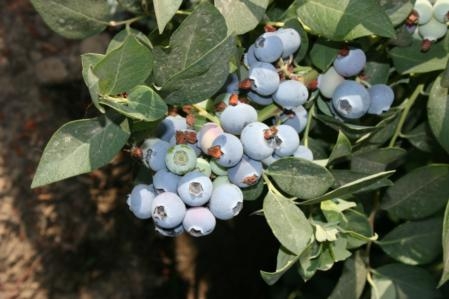Synopsis of: “The Organic Premium for California Blueberries” by Hoy Carmen, professor emeritus in the Agricultural and Resource Economics Dept., UC Davis
Commercial-scale production of blueberries in California is a relatively recent development. California first reported blueberry statistics in 2005 when there were 1,800 acres of blueberries harvested and production of 9.1 million pounds with a total value of $40.58 million. Harvested acres increased to 3,900 acres in 2010 with production of 28 million pounds and a total value of $75.98 million. Growth continued through 2015 with California Agricultural Statistics Survey (CASS) reporting 5,700 acres of blueberries harvested, production of 62.4 million pounds, and total value of $116.98 million.
California blueberries are shipped throughout the U.S. and to a number of export destinations. During the 2016 harvest, California's largest U.S. market was California, which accounted for 34.75% of California's total fresh blueberry shipments of 46,493,407 pounds.
The largest out-of-state domestic shipments were to Texas, Oregon, Washington, Arizona, New York, Minnesota, Utah, and Pennsylvania. These states collectively accounted for 36.54% of California shipments. Canadian shipments of 5.54 million pounds accounted for 11.9% of California's volume and made up 67.1% of exports.
Typically, the price per pound of organically grown blueberries is higher than for conventional production. Prices also vary by package size, with smaller package sizes usually selling for more per pound than larger packages. There is usually a premium for the first portion of the crop-marketing year, and the overall level of prices will vary by year. Prices can also be expected to vary by geographic location. California organic blueberries are among the first domestic fruit on the market when prices tend to be seasonally high.
Growth in California organic blueberry production has outpaced conventional production for several years, and California accounted for about half of the U.S. supply of organic blueberries in 2014. The organic share of California blueberry shipments in 2016 was 23.1% in terms of volume and 34.8% in terms of value. The larger share of value is due to the premium price for organic blueberries.
The organic premium, which averaged $2.28 per pound in both 2015 and 2016 (78–79% of the conventional fresh blueberry price), varies by package and over time. California has some of the earliest domestic blueberry production, with relatively high prices for both conventional and organic blueberries at the beginning of the season. The proportion of shipments that are organic decreases as the season progresses and the organic premium tends to be highest after the first one-third of the season. The growth of organic blueberry production in California, relative to overall California production as well as U.S. organic blueberry production, seems to indicate a comparative advantage for organic blueberries in California. Further growth of organic as well as total blueberry production in California is expected.
For the full article see:
Organic production costs, South Coast
Conventional costs, South Coast
Conventional, San Joaquin Valley
Report on US Organic Sales, 2016
https://www.nass.usda.gov/Newsroom/2017/09_20_2017.php
Attached Images:
